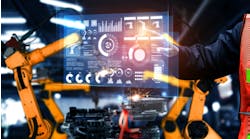Speed bumps with & lessons to be learned from the automotive-manufacturing supply chain
By Chris McNamara, Smart Industry editor in chief
The automotive industry is using smart manufacturing practices to eliminate supply chain issues and other obstacles to make smarter vehicles a reality. Perhaps you own one. These wins are particularly laudable, given current manufacturing challenges including economic uncertainty, expensive and scarce talent, and continued supply chain problems.
So what is unique about supply-chain issues with the automotive industry? And what can the rest of us learn from successful strategists in this space? Here we chat with Laurent Becher, Deloitte Consulting LLP, to find answers.
Smart Industry: What is unique about supply chain disruption within the auto industry?
Laurent: Cars and trucks are some of the most complex consumer products mass-produced: thousands of parts, components and complex sub-systems are assembled every minute. Not only is the product inherently complex, but some OEMs offer options and feature variants that multiply to the billions the number of possible unique vehicle configurations.
Many of these complex components and subsystems go through several tiers of suppliers before reaching the automotive OEMs. Cost pressures have resulted in many of these tiers being overseas. Capability specialization has also resulted in unique sources for some of the materials and components. OEMs have also taken just-in-time approaches to part fulfillment to limit the cost of inventory and strapped cash. The combination of an intricate product, complex multi-tiered supply chain, insufficiently multi-sourced materials and limited on-hand inventory has exposed automotive OEMs—more than others—to supply chain disruptions.
Many OEMs do not even know their supplier tiers beyond their Tier 1s; this has prevented them from monitoring and anticipating-supply disruptions. The infamous chip shortage is a good example of that.
Smart Industry: How did this industry pivot during the recent supply-chain crisis?
Laurent: Many OEMs have made complexity-reduction and supply-chain resiliency top priorities when thinking about development post-crisis. They have sought help to illuminate their supply-chain pathways, resulting in an understanding of the value chain beyond Tier 1s and, at times, all the way to the mines and sources of minerals. They also pivoted by implementing smart manufacturing technologies such as predictive-monitoring systems that can alert them of potential disruption risks.
Smart Industry: To what do you credit the auto industry's growth during recent challenges related to the economy, talent scarcity and supply-chain disruption?
Laurent: The automotive industry has seen growth in the last few years despite a number of challenges, in part due to the tremendous investments into its offerings. Not only have many added hybrid and electric vehicles to their product portfolios, some have added a multitude of value-add features for the consumer, ranging from safety to utility, infotainment, etc. Combined with pandemic-driven supply constraints, pent-up demand and the lack of stronger transportation alternatives as compared to other countries, the industry has been able to command higher prices without losing demand.
It’s also invested in automation to counter talent scarcity and create supply -resiliency capabilities to limit supply disruptions and their impact. It will be interesting to see how the future of mobility, autonomous driving, ride-sharing and remote work impact overall demand going forward. More fundamental changes to their business models will be required for automotive OEMs to continue to extend their growth.
Smart Industry: What is a prime area of growth for OEMs in this space?
Laurent: Electric vehicles are a prime area of growth, particularly as high production costs are being partially offset by government incentives, and as OEMs are leveraging the technology to offer additional value-add services to their customers. Electric vehicles also offer new business-model opportunities and sources of value-generation through battery-management services. Electric vehicles, connected technologies and emerging capabilities such as autonomous driving have the potential to fundamentally transform mobility overall and force OEMs to continue rethinking both their operating and business models.
There are already clear opportunities to leverage the product to transform the way vehicles are manufactured.
Smart Industry: How / why are auto manufacturers focusing on external disruptions? How are the savviest mitigating negative effects of external problems?
Laurent: Best-in-class OEMs are attacking the problem from several angles: on one hand, they dramatically reduce their unnecessary, excessive and unprofitable (“bad”) complexity, bringing down their part variants and overall product-offering complexity from billions of possible configurations to dozens, enabling them to simplify both their raw and finished-good inventories. On the other hand, they illuminate their entire supply base, start monitoring for multiple types of disruption risk (financial, economic, environmental, etc.) and deploy risk-mitigation measures that range from structural to tactical (near or re-shoring, dual sourcing, flexible scheduling, multi-lane production strategy, etc.).
The savviest manufacturers are engineering advantage in the marketplace by investing in smart manufacturing technologies that help synthesize plant data to make faster and more informed decisions.



